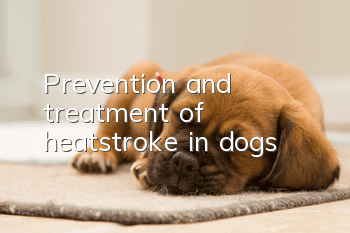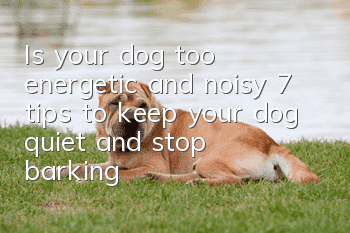Prevention and treatment of heatstroke in dogs!

Case of dog death due to heat stroke
It often happens at home and abroad
Some hosts thought they were just going to buy something
Be back soon
So I left the dog in the car
When I came back, I found that the dog couldn’t stand the heat
Dogs are very heat-intolerant animals:
Because dogs don’t sweat, nor do they stop moving because of heat; a dog’s body cannot regulate its own temperature, and dogs cannot take care of themselves and replenish water in a timely manner; a dog’s sweat glands are all on the tongue, so seeing a dog sticking out its tongue and panting means that Dogs are very hot and need to drink water to cool down or calm down to stop activities; dogs with short noses are more afraid of heat than dogs with long noses and are less likely to dissipate heat.
The normal body temperature of a dog should be 37.8-39 degrees. When the body temperature reaches 40.65 degrees, the internal organs begin to be damaged. When the body temperature reaches 41 degrees or above, it is considered to be highly dangerous. In a high-heat environment or a high-humidity and hot climate, a dog's body system may fail and die in as little as 20 minutes. Therefore, heatstroke is the biggest threat to dog health in summer or other hot and humid weather conditions.
Symptoms of heatstroke in dogs:
Panting loudly with the mouth open, with murmurs in the lungs and saliva on the mouth; body swaying and losing balance when walking; weakness; confusion, and finally falling to the ground and death.
When a dog shows symptoms of heatstroke, the owner should immediately take self-rescue rather than waiting for the veterinarian. The most important thing is to lower the dog's body temperature as soon as possible. The method is to pour cold water (not ice water, which will slow down the skin's circulation speed and prolong the cooling time) to the dog's body. You can also put it on the dog's body. The dog was placed in a cold tub to cool down. The dog should then be taken to a veterinary clinic as quickly as possible. Dogs generally won't drink water on their own in this situation, so they need to be sent to the veterinarian for quick rehydration and other treatment through drips and other methods.
Treatment of dog heatstroke:
Summer is coming soon, and whether your pet is a dog, cat or rabbit, there are signs of heatstroke. When a pet appears to be panting rapidly, restless, or barking, there are already signs of heatstroke. Then there will be difficulty breathing, raising the neck to breathe or being sluggish. If appropriate treatment is not done at this time, the pet will go into shock, become comatose, and eventually die.
To prevent dog heatstroke, you can start from several aspects:
[Living environment]: Place the pet in a place with good air circulation and avoid sunlight. If necessary, provide it with an electric fan or install an air conditioner indoors.
[Life Management]: Long-haired pets can be shaved to help dissipate heat, and sufficient water should be added at any time.
[Outdoor activities]: Avoid taking pets out when the temperature is high. If you want to go out, you must bring drinking water and reduce the amount of exercise.
【Be alert】: Pay attention to whether pets have abnormal behaviors or symptoms at any time, especially short-nosed cats or dogs, and obese animals are prone to heat stroke, so pet owners should pay special attention.
To determine whether a pet has heatstroke, in addition to judging by the pet's external behavior and reactions, owners can also touch or observe. For example, if the pet is in a stuffy or high-temperature environment, if the body temperature is much higher than usual, or if the skin on the hairless part of the pet's abdomen appears flushed, with extensive bleeding spots, bleeding spots, etc., these are possible signs of heat stroke.
When a pet has symptoms of heat stroke, the first step for the owner is to untie the collar and items hanging on the pet. If your pet only suffers from mild heatstroke such as drooling, panting, and restlessness, you can first lower the ambient temperature, such as moving the pet to a shady place, or giving it an electric fan or air conditioner to cool it down, and then give it an appropriate amount of water to slowly recover. . If the pet has difficulty breathing and appears sluggish, wet the pet's body with cold water at the nearest location, or half-immerse it in water, and then send it to a doctor for first aid.
When a pet is in a coma due to severe heatstroke shock, first wet it with ice water or wrap the whole body with an ice towel. You can also wipe it with alcohol to cool down, or pour cold water from the anus into the rectum, and then send it to the doctor as soon as possible. On the way to the hospital, pay attention to lowering the pet's head and straightening its neck to keep the respiratory tract open and prevent vomiting.
- How do you know your dog has entered the birth canal?
- Why are dogs allergic to dog food? What specific symptoms?
- 8 common reasons why dogs vomit
- What is the cause of alopecia in dogs?
- What kind of dog food is good for Huskies? What else should you pay attention to when choosing dog food?
- The Three Stages of Scottish Sheepdog Training
- How to tell the difference between an Alaskan and a Husky
- What should I do if Corgi is picky and won’t eat dog food?
- Can dogs eat dates?
- How to judge whether a black teddy is pure or not



